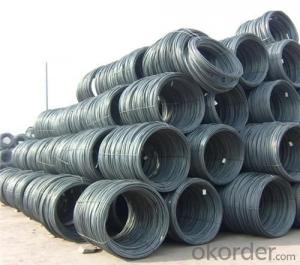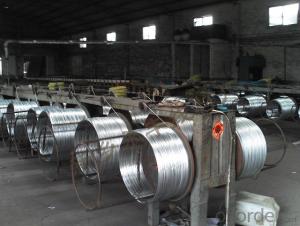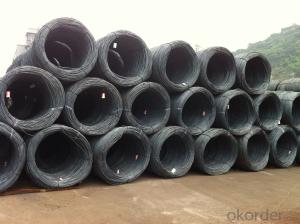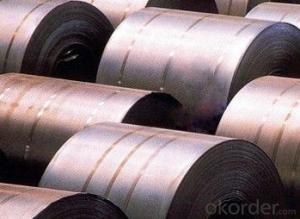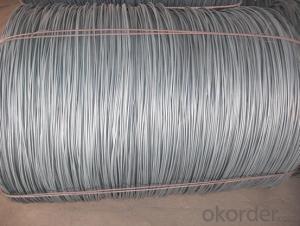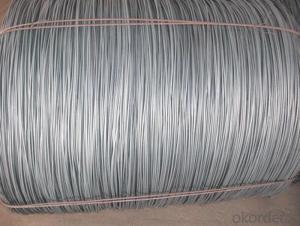Q195 low carbon wire galvanized steel wire rod
- Loading Port:
- Tianjin
- Payment Terms:
- TT OR LC
- Min Order Qty:
- 500 m.t.
- Supply Capability:
- 1000000 m.t./month
OKorder Service Pledge
OKorder Financial Service
You Might Also Like
1. Introduction:
.commodity:steel wire rod
.grade:Q195,SAE1008B-SAE1018B
.diameter:5.5mm-14mm
.type:in coil
.coil weight:around 2 mt
2. Specifications:
. Wire Gauge: 5.5mm, 6.5mm, 8mm, 9mm, 10mm, 11mm, 12mm
. Material: SAE1006, SAE1008,Q195,Q235,77B,82B
. Package: in coils
. Coil weight: 1.8-2.1 tons
. Application: Construction building, netting, package, rope and so on.
. The third party inspection: BV SGS China national construction steel quality supervision and test centre
3.Application:
Applicationwidely used in machinery parts, manufacturing industry, electronics industry, metal tools and others
4. Pictures
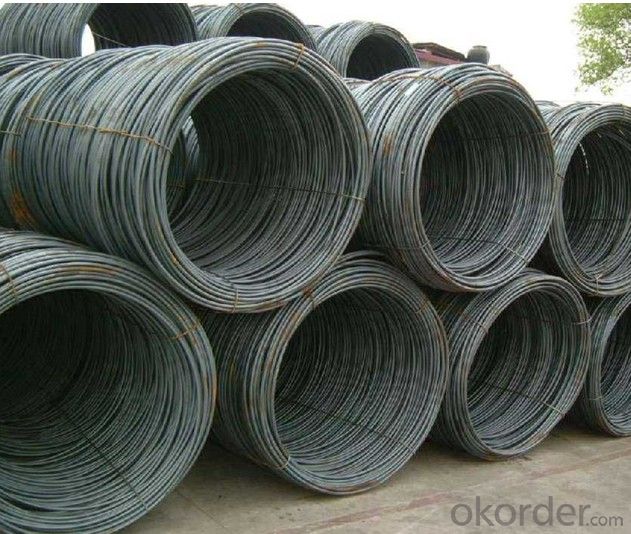
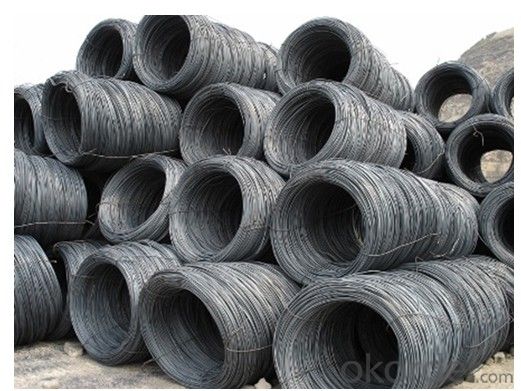
5.FAQ
We have organized several common questions for our clients,may help you sincerely:
①How about your company?
A world class manufacturer & supplier of castings forging in carbon steel and alloy steel,is one of the large-scale professional investment casting production bases in China,consisting of both casting foundry forging and machining factory. Annually more than 8000 tons Precision casting and forging parts are exported to markets in Europe,America and Japan. OEM casting and forging service available according to customer’s requirement.
②How to guarantee the quality of the products?
We have established the international advanced quality management system,every link from raw material to final product we have strict quality test;
- Q:What are the different types of steel wire rod surface defect analysis tools?
- There are various types of tools used for the analysis of surface defects in steel wire rods. Some commonly used tools include optical microscopes, scanning electron microscopes (SEM), digital imaging systems, and surface profilometers. These tools allow for detailed examination of the wire rod surface at different magnifications, enabling the identification and characterization of various types of defects such as cracks, pits, scratches, and scale.
- Q:What are the common industry trends for steel wire rod?
- Some common industry trends for steel wire rod include increasing demand from the construction and automotive sectors, advancements in technology leading to improved product quality and efficiency, growing emphasis on sustainability and recycling practices, and the emergence of new markets and applications for steel wire rod products.
- Q:What are the different types of steel wire rod surface defects after wire drawing?
- There are several different types of steel wire rod surface defects that can occur after wire drawing. Some common examples include scratches, pits, scale, cracks, and uneven surfaces. These defects can affect the quality and performance of the wire, so it is important to identify and address them in order to ensure the desired product quality.
- Q:How is steel wire rod used in the manufacturing of wire harnesses?
- Steel wire rod is used in the manufacturing of wire harnesses as it serves as the core material for the electrical conductors. The wire rod is first drawn through a series of dies to reduce its diameter and form a long, continuous wire. This wire is then twisted or braided with other wires to create the desired shape and structure of the wire harness. The steel wire rod provides the necessary strength and durability for the harness to withstand the electrical currents and mechanical stresses it may encounter during its use.
- Q:How is steel wire rod measured and classified?
- Steel wire rods are typically measured and classified based on their diameter and mechanical properties. The diameter of a steel wire rod is measured using a gauge, which determines its thickness. The classification is based on the wire rod's tensile strength, yield strength, and elongation characteristics. These properties help categorize the wire rod into different grades, such as low carbon, medium carbon, or high carbon steel, which are used for various applications in industries like construction, automotive, and manufacturing.
- Q:What are the main factors affecting the market consolidation of steel wire rod?
- The main factors affecting the market consolidation of steel wire rod include global demand and consumption patterns, price fluctuations and competition, technological advancements, government regulations and policies, and the overall economic conditions. Additionally, factors such as mergers and acquisitions, industry restructuring, and the presence of major players in the market also contribute to the consolidation process.
- Q:What are the different types of steel wire rod surface defect repair methods?
- There are several different types of steel wire rod surface defect repair methods, including grinding, polishing, coating, and heat treatment. Each method is used to address specific types of surface defects, such as scratches, pits, or corrosion. Grinding involves removing the surface layer of the rod to eliminate defects, while polishing smoothens the surface and enhances its appearance. Coating methods, such as electroplating or galvanizing, are used to provide a protective layer against future defects. Heat treatment methods, such as annealing or quenching, can be employed to improve the strength and durability of the wire rod surface. Overall, the choice of repair method depends on the type and severity of the surface defect, as well as the intended application of the steel wire rod.
- Q:How does the corrosion resistance of steel wire rod vary with different coatings?
- The corrosion resistance of steel wire rod can vary significantly with different coatings. Coatings such as zinc, galvanized, or epoxy can provide a protective barrier against moisture and corrosive elements, thereby enhancing the lifespan and durability of the wire rod. The choice of coating depends on the specific application and the environmental conditions the wire rod will be exposed to.
- Q:How is the steel wire rod market affected by fluctuations in foreign exchange rates?
- Fluctuations in foreign exchange rates have a notable influence on the steel wire rod market. Given its highly globalized nature, steel wire rod is frequently traded internationally, and its prices are subject to currency exchange rate fluctuations. When a country's currency weakens against major foreign currencies, its exports become more competitive in international markets. This, in turn, can spur demand for steel wire rod from that country, as it becomes more affordable for foreign buyers. Consequently, the steel wire rod market experiences an upswing in sales, potentially leading to price increases due to heightened demand. Conversely, when a country's currency strengthens, its exports become pricier for foreign buyers. This can result in decreased demand for steel wire rod from that country, leading to lower sales and potential price reductions. Fluctuations in foreign exchange rates can introduce uncertainty and volatility to the steel wire rod market, making it challenging for manufacturers, suppliers, and distributors to plan and forecast their operations effectively. Moreover, currency fluctuations can impact the cost of raw materials and production processes. Steel wire rod manufacturers often rely on imported raw materials, such as iron ore and scrap metal, which are priced in foreign currencies. If a country's currency weakens, the cost of importing these raw materials may rise, resulting in higher production costs and potentially increased steel wire rod prices. Additionally, foreign exchange rates affect the competitiveness of steel wire rod imports. A higher-valued currency makes it more cost-effective to import steel wire rod from other countries. Consequently, this can instigate heightened competition for domestic manufacturers, potentially leading to reduced market share and profitability. To summarize, fluctuations in foreign exchange rates have a significant impact on the steel wire rod market. They influence the competitiveness of exports, the cost of raw materials, the pricing of steel wire rod, and the competitiveness of imports. Participants in the steel wire rod market must vigilantly monitor and analyze foreign exchange rates to effectively anticipate and respond to market dynamics.
- Q:How is steel wire rod used in the manufacturing of wire rope chains?
- Steel wire rod is used in the manufacturing of wire rope chains as it serves as the raw material for producing the individual wires that make up the chain. The steel wire rod is first drawn down to the desired diameter and then twisted together to form strands, which are further twisted around a core to create the final wire rope chain. The strength and durability of the steel wire rod ensures the chain's ability to bear heavy loads and withstand rigorous usage in various industries and applications.
1. Manufacturer Overview |
|
|---|---|
| Location | |
| Year Established | |
| Annual Output Value | |
| Main Markets | |
| Company Certifications | |
2. Manufacturer Certificates |
|
|---|---|
| a) Certification Name | |
| Range | |
| Reference | |
| Validity Period | |
3. Manufacturer Capability |
|
|---|---|
| a)Trade Capacity | |
| Nearest Port | |
| Export Percentage | |
| No.of Employees in Trade Department | |
| Language Spoken: | |
| b)Factory Information | |
| Factory Size: | |
| No. of Production Lines | |
| Contract Manufacturing | |
| Product Price Range | |
Send your message to us
Q195 low carbon wire galvanized steel wire rod
- Loading Port:
- Tianjin
- Payment Terms:
- TT OR LC
- Min Order Qty:
- 500 m.t.
- Supply Capability:
- 1000000 m.t./month
OKorder Service Pledge
OKorder Financial Service
Similar products
New products
Hot products
Hot Searches
Related keywords

